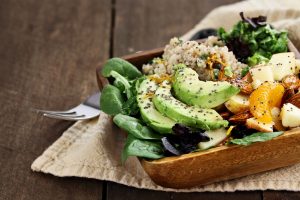
The liver is the only organ that can regenerate and heal itself, and this may be possible if cirrhosis is mild. If severe, though, the progression of cirrhosis will eventually bring the function of the liver to a halt.
The good news is, a healthy diet can go a long way in slowing down the progression of cirrhosis, all the while maintaining a healthy liver and healthy body overall. Below you will find the foods to eat and the ones to avoid if you have cirrhosis.
Diet and nutrition tips for people with cirrhosis
Limit salt: Salt retains water, which can cause further problems for cirrhosis patients. It is important that you limit your salt intake to less than 2,000 mg a day or less. You can do this by avoiding salty foods, cooking for yourself, reading food labels carefully, avoiding fast-food restaurants, and reducing your intake of red meat.
Watch your calories and protein: Cirrhosis patients may need additional calories and protein as they may lose their appetite or experience nausea or vomiting, leading to weight loss. Eating smaller, more frequent meals may help combat this while replenishing lost nutrients, calories, and protein. Protein should come from plant sources as meat-sourced protein is hard for your liver to filter through.
Avoid alcohol: In many cases, alcohol is a main cause for cirrhosis, so continuing to drink will worsen your condition. Avoid alcohol at all costs.
Limit fat: A high-fat diet can worsen cirrhosis as it contributes to fatty liver disease – another cause of cirrhosis. No more than 30 percent of your calories should come from fat.
Avoid caffeinated beverages: Caffeinated beverages have been found to worsen liver disease.
Maintain a healthy weight. Some forms of liver disease, including cirrhosis, are linked to fat accumulation.
Reduce your risk of developing hepatitis. Do not share needles, ensure you are vaccinated, and be aware of the risk of hepatitis when traveling to foreign countries.
Avoid infections. Cirrhosis makes it difficult to fight off infections. Avoid people who are sick and wash your hands frequently.
Don’t smoke. This is toxic to the liver.
Avoid risky sexual behaviors. Avoid having multiple partners and engaging in unprotected sex, as it can increase your risk of hepatitis and other infections.
Don’t do illicit drugs. These too increase your risk of hepatitis and infection.
Manage other health conditions. Control blood pressure, cholesterol, and diabetes as these can all take a toll on your liver, worsening your disease.
Avoid harmful medications: Medications are processed through the liver, so certain drugs can worsen your condition.
Sample menu for people with liver disease
Breakfast: Bowl of cooked oats with milk, and a small cup of fruit.
Mid-day meal: Sandwich with thin slices of chicken or turkey, or a sandwich with peanut butter. Low-fat yogurt and two biscuits.
Lunch: Fresh fruit or alfalfa sprouts, whole wheat bread, a cup of boiled or sautéed vegetables like beans, broccoli, or carrots, chicken breast, and cup of yogurt.
Evening snack: Either a small fruit or a cup of milk.
Dinner: Fried brown rice with cottage cheese and boiled vegetables, and a tossed salad.
If you have cirrhosis or another type of liver disease, your doctor will most likely set you up with a dietician or nutritionist to help you create a personalized eating menu in order to aid in treatment.